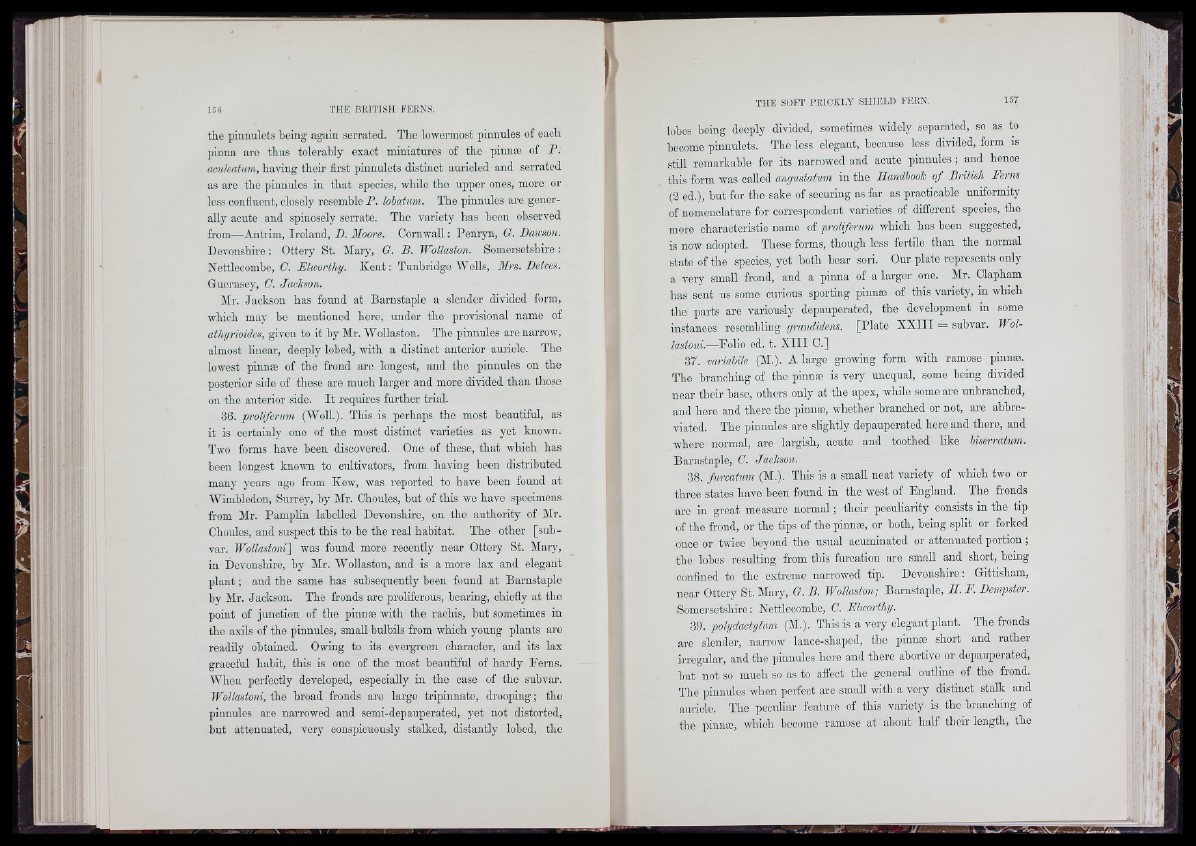
tlie pinnulets being again serrated. The lowermost pinnules of each
pinna are thus tolerably exact miniatures of the pinnæ of P .
aculeatum, having their first pinnulets distinct auricled and serrated
as aro the pinnules in that species, whilo the upper ones, more or
less confluent, closely resemble P . lohatum. The pinnules aro generally
acute and spinosely serrate. The variety has boon observed
from—Antrim, Ireland, P . Moore. Cornwall : Penryn, G. Dawson.
Devonshire : Ottery St. Mary, Q. B. Wollaston. Somersetshire :
Nettlooombo, C. Elworthy. Kent; Tunbridge lYells, Mrs. Delves.
Guernsey, C. Jachson.
Mr. Jackson has found at Barnstaple a slender divided form,
which may be mentioned here, under the provisional name of
athyrioides, given to it by Mr. "Wollaston. The pinnules aro narrow,
almost linear, deeply lobed, with a distinct anterior auricle. The
lowest piimæ of the frond aro longest, and the pinnules on the
posterior side of these are much larger and more divided than those
on the anterior side. I t requires further trial.
36. proliferum (Woll.). This is perhaps the most beautiful, as
it is certainly one of the most distinct varieties as yet known.
Two forms have been discovered. One of these, th a t Yvhioh has
been longest knowm to cultivators, from having been distributed
many years ago from Kew, was reported to have been found at
IVimbledon, Surrey, by Mr. Choules, but of this we have specimens
from Mr. Pamplin labelled Devonshire, on the authority of Mr.
Choules, and suspect this to be the real habitat. The other [subvar.
Wollastoni] was found more recently near Ottery St. Mary,
in Devonshire, hy Mr. Wollaston, and is a more lax and elegant
plant ; and the same has subsequently been found at Barnstaple
by Mr. Jackson. The fronds are proliferous, hearing, chiefly at the
point of junction of the pinnæ with the raohis, but sometimes in
the axils of the pinnules, small bulbils from which young plants are
readily obtained. Owing to its evergreen character, and its lax
graceful habit, this is one of the most beautiful of hardy Ferns.
IVhen perfectly developed, especially in the case of the subvar.
Wollastoni, the broad fronds are large tripinnate, drooping; the
pinnules are narrowed and semi-depauperated, yet not distorted,
but attenuated, very conspicuously stalked, distantly lobed, the
lobes being deeply divided, sometimes widely separated, so as to
become pinnulets. The less elegant, because less divided, form is
still remarkable for its narrowed and acute pinnules ; and hence
this form was called angustatum in the Handbook of British Ferns
( 2 ed.), but for the sake of securing as far as practicable uniformity
of nomenclature for correspondent varieties of different species, the
more characteristic name of proliferum which has been suggested,
is now adopted. These forms, though less fertile than the normal
state of the species, yet both hear sori. Our plate represents only
a very small frond, and a pinna of a larger one. Mr. Clapham
has sent us some curious sporting pinnæ of this variety, in which
the parts are variously depauperated, the development in some
instances resembling grandidens. [Plato X X II I = subvar. Wollastoni.—
Folio ed. t. X I I I C.]
37. variabile (M.). A large growing form with ramose pinnæ.
The branching of the pinnæ is very unequal, some being divided
near their base, others only at the apex, while some aro unbranched,
and here and there the pinnæ, whether branched or not, are abbreviated.
The pinnules are slightly depauperated here and there, and
whore normal, are largish, acute and toothed like biserratum.
Barnstaple, C. Jackson.
38. furcatum (M.). This is a small neat variety of which two or
throe states have been found in the west of England. The fronds
aro in great measure normal ; their peculiarity consists in the tip
of the frond, or tho tips of the pinnæ, or both, being split or forked
once or twice beyond the usual acuminated or attenuated portion ;
the lobes resulting from this furcation are small and short, being
confined to tho extreme narrowed tip. Devonshire; Gittisham,
near Ottery St. Mary, G. B. Wollaston; Barnstaple, H. F. Dempster.
Somersetshire; Nettlocombo, C. Elworthy.
39. polydactylum (M.). This is a very elegant plant. The fronds
are slender, narrow lanoe-shaped, the pinnæ short and rather
irregular, and the pinnules here and there abortive or depauperated,
but not so much so as to affect tho general outline of the frond.
Tho pinnules when perfect are small with a very distinct stalk and
auriclo. Tho peculiar feature of this variety is tho branching of
the piunæ, which become ramose at about half thoir length, the